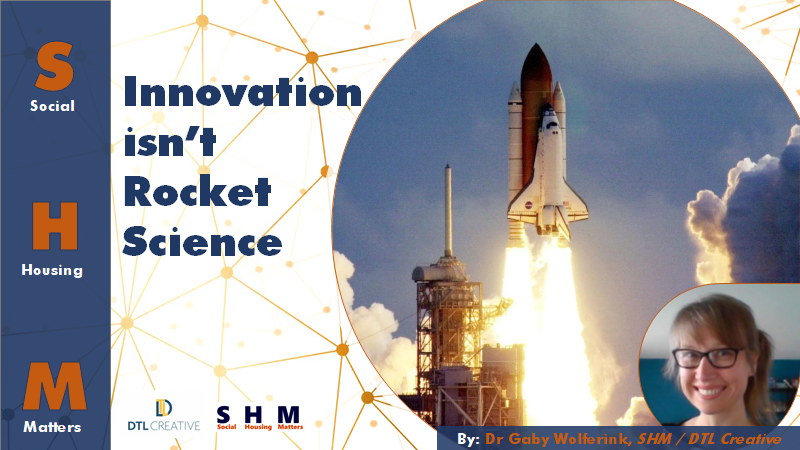By: Dr Gaby Wolferink

Rocket science, or space engineering, is perhaps one of the pinnacles of innovation. In 1969 it was confirmed, after quite a few attempts, we had built a rocket that has put humanity on the moon.
Since then, we have built rockets that have launched entire exploration robots to be sent to Mars to dig around in soil and analyse the atmosphere and rocks (and send those data back to Earth!). We have rockets that have propelled probes like Voyager 2 that is now the outer edges of our solar system, continuing to communicate information back to earth after more than 40 years. Rockets that carried equipment that got us amazing pictures of planets like Saturn that up until a few years ago seemed nothing more than just blurry flocks of dust on the lens of a camera.
Recently, the team led by Dr Katie Bouman capturing images of a friggin’ black hole. A black hole! This image, the first of its kind, now looks like those flocks of dust that we had to work with for our own solar system planets, but I am sure that innovation will take us ever closer to learning more about and seeing more of that black hole than just the flock of dust on the camera-image. We will see more details of that black hole, of other solar systems and whatever we might find out there. It is amazing and speaks to the imagination. The Star Trek geek in me (and there’s quite a big one in here) lives for this shit.
Real innovation is space engineering, electric cars going further thanks to among other things the cutting-edge technology developed by Formula 1 and Formula E. It is the latest computers and mobile phones. Innovation is tech and data. It’s apps and gadgets. It’s smart watches and step counters that can tell you how close you are to walking to the moon and back to Earth (if you’d want to come back at this rate, that is..) Real innovation is sparkly and sexy. Real innovation fits in your pocket (if you’re a man, if you’re a woman you don’t get (usable) pockets…). Real innovation is expensive and most innovation comes from government-backed organisations (NASA), rich companies or individuals (Tesla). But is it really?
It’s the thought that counts
Because we think of things like rockets, Mars rovers and Formula E cars when we think of the word ‘innovation’, innovation sounds like something that mostly happens in ‘science’ and ‘tech’. So, when businesses, including housing associations, want to ‘innovate’, a lot of this is focused on introducing new technology and systems that should make life easier. Therefore, in turn, a lot of roles that are responsible for ‘innovation’ within the organisation can be found with ‘IT people’ and/or ‘data people’.
In doing so we continue to feed the fallacy that innovation starts with and centres around (the realm of) technology. And… in a way we take away the very human element to it that would remind us that just because rocket science is innovation, innovation isn’t rocket science.
In a way, to throw in a cliché, because why not, it’s the thought that counts. Every idea starts with a thought, sparked sometimes by excitement, very often by frustration, the thought of ‘Oh come on, this should be better/different/easier!’. Technology is merely one of the many kinds of outputs of someone’s drive to innovate, to make things better or easily. Yes, I firmly believe that at its core, more often than not, there are human traits like curiosity and a drive to help people that drive innovation output, regardless of how these practical outputs end up being used or for how much it is sold. In this issue of .Digital Bark alone there’s two prima examples of this.
Expectation feeds frustration feeds innovation in myriad of forms
Frustration 1: “THAT’S UGLY AS HELL!”
I’m going out on a limb here, but I’m guessing that nobody experiencing a decline in mobility has ever uttered something along the lines of:
‘I love these bulky plastic handrails outside of my door that scream ‘I’m not as nimble as I used to be!’ to any potential burglars!’ or ‘I absolutely adore the big bulky grips next to my toilet and in my shower that remind me every day that my body is having issues I’d rather not have!’
The people behind Invisible Creations sure never heard anyone say that. In fact, quite the opposite. In short, Invisible Creations are responsible for designing and selling a growing range of dual-purpose items that aren’t ugly as hell but offer support and keep people safe in their own homes longer. These items combine supportive grips and handles with everyday items that are often found in the same place in or outside the home, like a hanging plant pot that also functions as a support grip to keep your balance if your doorstep is a bit higher and cannot easily be lowered.
Their idea is SO BASIC. So SIMPLE. So GENUINE. When it was presented at the National Housing Federation Summit 2 years ago, many people around me, including myself, were muttering. ‘This is genius, but seriously: why has nobody thought of this before? Why have I not thought of this before?’ After all, it’s literally not rocket science.
But it is revolutionary in all its simplicity. It’s something that should have been done years ago, but for some reason hadn’t been done until now. Could that reason be that we focus so much on technological, shiny, and expensive solutions that we overlook the ones that are right in front of us?
Frustration 2: “WE NEED MORE HOMES! SERIOUSLY, GOVERNMENT!! OK, WE’LL DO IT OURSELVES THEN!“
Another big frustration is the ongoing housing crisis and how difficult it is to solve without proper government backing to build more social (not just affordable, SOCIAL!) housing.
‘Stichting Statiegeld op Jeugd’ (Website in Dutch) (SoJ), a Dutch initiative that translates directly as ‘Deposit on Youth’ has had enough, because unfortunately, the housing crisis isn’t confined to just the UK. Fed by frustration they have developed a way to create more social housing without building a single new home, all the while strengthening communities and increasing social support in a time where government support for public services is dwindling every time we blink. The innovation in SoJ’s idea isn’t technological. It’s a new way of thinking about living, life and communities. Their idea is simple too:
We have a situation where we are dealing with an ageing population, living comfortably in their big family homes, but with kids moving out, they have a lot extra space that isn’t really or hardly used after their kids move out.
Then there are young people struggling to get onto the housing ladder, as well as not having access to social and affordable homes in the communities they love. So, SoJ thought “WE NEED MORE HOMES! But…There’s an opportunity here! What if we work with social housing providers and homeowners to free up that space for social housing??”
SoJ does so by supporting all parties in splitting up these homes officially, offering these 1st floor apartments for social and affordable rents for younger people and others, like divorced parents who want to stay close to their families, and at the same time broker and ensure both parties upholding a social contract of support between the home owner and the tenant, with for example gardening and shopping is maintained.
You can read more about SoJ in this article here.
Listen up: Innovation can come from and is for everyone
Like the vision of Invisible Creations, the kind of thinking of Stichting Statiegeld op Jeugd isn’t rocket science either. It’s ‘merely’ the things that are right in front of our eyes that need to be seen by people who aren’t distracted by the shiny sparkly techy things that are calling you from the distance as the one and only ‘solution’. The people coming up with these particular ideas weren’t IT people either, they weren’t data people.
They were, in fact, in this case, PR and Comms/Marketing people. People who deal in language and communication. People who deal in how others see and experience the world. People who deal in listening to and telling their own stories. This is, for me, where innovation starts and why it shouldn’t just be placed in the hands of ‘IT and Data people’.
Yes, this is an IT and tech-centred magazine. Yes, I work in an IT and tech/data-centred role, and I will not talk down the great innovation that is going on in that realm within social housing, because, gosh, do I love it! But we have to be careful to silence and scare away the ideas that come from outside the realm of technology, whether or not the ideas will lead to technological innovations or not.
Innovation, for me, starts with stories and listening to the stories of others. Whether it’s stories of frustration, sadness, excitement, or curiosity, they can all spark that one (beginning of an) idea that can lead to innovation. It’s ideas like Invisible Creations and Stichting Statiegeld op Jeugd that show us, once more, that while rocket science is innovation, innovation isn’t rocket science. It’s people listening to and talking to other people.
About this Article
This article was first published in .Digital Bark magazine #3, published by DtL Creative in November 2020.
.Digital Bark is a magazine that shares the newest ideas, innovation and technology in housing in a way that speaks to all kinds of audience, whether you’re an IT expert or not! Have a look here!




